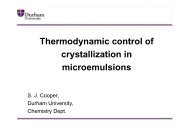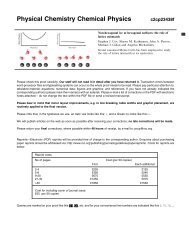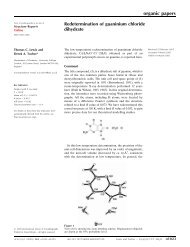ADVANCED USERS DMACRYS & NEIGHCRYS manual Manual ...
ADVANCED USERS DMACRYS & NEIGHCRYS manual Manual ...
ADVANCED USERS DMACRYS & NEIGHCRYS manual Manual ...
Create successful ePaper yourself
Turn your PDF publications into a flip-book with our unique Google optimized e-Paper software.
Printed output<br />
If the relaxation vector is sufficiently small, <strong>DMACRYS</strong> will assume that a valid minimum has been found.<br />
Currently the distance used in this test is 5.0*10E-06 lattice units, and the program terminates if all<br />
displacements of all symmetry adapted variables are less than this value.<br />
If PRIN MINI is set to a value greater than one, the following output will be obtained.<br />
MINIMISATION SETUP<br />
This is printed every time the inner iterative loop is entered. Usually this will be once only on the first<br />
iteration, unless one of the Hessian recalculation options is used.<br />
GD1 = F<br />
This is written twice after the MINIMISATION SETUP message. The first value F is the value of<br />
G.DELTA, the second is the value of G.DELTA scaled if necessary to keep all of the elements of delta<br />
within RMAXSF. G.DELTA should be negative indicating a decrease of energy in the search direction. If<br />
the first value of GD1 is positive, the direction of the search is reversed to ensure that the energy decreases.<br />
ALPHA= F1 ALPHA2= F2<br />
This message occurs after MINIMISATION SETUP or after CHANGE DIRECTION. (See below). ALPHA<br />
and ALPHA2 will both be one in this case. ALPHA is the current fraction of DELTA to be applied.<br />
ALPHA2 is the total fraction of DELTA applied since the last Hessian update.<br />
GD1= F1 GD2= F2<br />
This is printed every cycle except for MINIMISATION SETUP cycles. GD1 is the previous value of<br />
G.DELTA, GD2 is the value calculated at the position after the step in the search direction. If the<br />
minimisation is working correctly, the magnitude of GD2 should be less than GD1.<br />
If ABS(GD2/GD1) is less than 0.25, the following is printed.<br />
CHANGE DIRECTION<br />
GD1 = F1<br />
ALPHA= F2 ALPHA2= F3<br />
HESSIAN UPDATE COMPLETE ... GD1= F4 GD2= F5 IKIND= I1 DELMAX= F6 IN COMPONENT I2<br />
Lattice energy = energy (in internal units) (Repulsion-dispersion cutoff = cuto lattice<br />
units)<br />
Where<br />
F4<br />
F5<br />
I1<br />
F6<br />
I2<br />
is the value of G.DELTA calculated from the updated Hessian and the new search direction<br />
DELTA. (DELTA = Hessian.G).<br />
is zero.<br />
is 0 if the Davidon-Fletcher-Powell algorithm has been used to update the Hessian.(R. Fletcher<br />
and M. J. D. Powell. Computer J. 6 (1963) 16) I1 is 1 if the Broyden, Fletcher and Shanno<br />
algorithm has been used. (C. G. Broyden. J. Inst. Maths. Applns. 6 (1970) 66 and 222. D. F.<br />
Shanno. Math. Computing 24 (1970) 647.)<br />
is the maximum displacement of a symmetry adapted variable. If F3 is greater than RMAXSF<br />
the search direction will be scaled so that the maximum displacement is RMAXSF.<br />
is the index of the variable with the maximum displacement.<br />
GD1 = F1<br />
ALPHA = F1 ALPHA2 = F2<br />
These messages are described above under MINIMISATION SETUP.<br />
32







